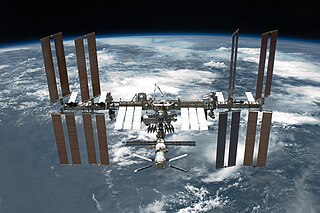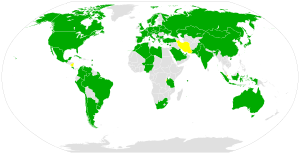
The Outer Space Treaty, formally the Treaty on Principles Governing the Activities of States in the Exploration and Use of Outer Space, including the Moon and Other Celestial Bodies, is a multilateral treaty that forms the basis of international space law. Negotiated and drafted under the auspices of the United Nations, it was opened for signature in the United States, the United Kingdom, and the Soviet Union on 27 January 1967, entering into force on 10 October 1967. As of August 2023, 114 countries are parties to the treaty—including all major spacefaring nations—and another 22 are signatories.

Space law is the body of law governing space-related activities, encompassing both international and domestic agreements, rules, and principles. Parameters of space law include space exploration, liability for damage, weapons use, rescue efforts, environmental preservation, information sharing, new technologies, and ethics. Other fields of law, such as administrative law, intellectual property law, arms control law, insurance law, environmental law, criminal law, and commercial law, are also integrated within the space law.
The Agreement Governing the Activities of States on the Moon and Other Celestial Bodies, better known as the Moon Treaty or Moon Agreement, is a multilateral treaty that turns jurisdiction of all celestial bodies over to the participant countries. Thus, all activities would conform to international law, including the United Nations Charter.

The United Nations Office for Outer Space Affairs (UNOOSA) is an office of the U.N. Secretariat that promotes and facilitates peaceful international cooperation in outer space. It works to establish or strengthen the legal and regulatory frameworks for space activities, and assists developing countries in using space science and technology for sustainable socioeconomic development.

Extraterrestrial real estate refers to claims of land ownership on other planets, natural satellites, or parts of space by certain organizations or individuals. Previous claims are not recognized by any authority, and have no legal standing. Nevertheless, some private individuals and organizations have claimed ownership of celestial bodies, such as the Moon, and are actively involved in "selling" parts of them through certificates of ownership termed "Lunar deeds", "Martian deeds" or similar.

The militarisation of space involves the placement and development of weaponry and military technology in outer space. The early exploration of space in the mid-20th century had, in part, a military motivation, as the United States and the Soviet Union used it as an opportunity to demonstrate ballistic-missile technology and other technologies having the potential for military application. Outer space has since been used as an operating location for military spacecraft such as imaging and communications satellites, and some ballistic missiles pass through outer space during their flight. As of 2018, known deployments of weapons stationed in space include only the Almaz space-station armament and pistols such as the TP-82 Cosmonaut survival pistol.

The United Nations Committee on the Peaceful Uses of Outer Space (COPUOS) is a United Nations committee whose main task is to review and foster international cooperation in the peaceful uses of outer space, as well as to consider legal issues arising from the exploration of outer space.
The development of Ugandan space initiatives has been largely shaped by that country's position on the equator. Its history is marked by an early involvement in issues of space law, and in 2022 by the launch of its first satellite, PearlAfricaSat-1.
The International Designator, also known as COSPAR ID, is an international identifier assigned to artificial objects in space. It consists of the launch year, a three-digit incrementing launch number of that year and up to a three-letter code representing the sequential identifier of a piece in a launch. In TLE format the first two digits of the year and the dash are dropped.

The Agreement on the Rescue of Astronauts, the Return of Astronauts and the Return of Objects Launched into Outer Space, also referred to as the Rescue Agreement is an international agreement setting forth rights and obligations of states concerning the rescue of persons in space. The Agreement was created by a 19 December 1967 consensus vote in the United Nations General Assembly. It came into force on 3 December 1968. Its provisions elaborate on the rescue provisions in Article V of the 1967 Outer Space Treaty. Despite containing more specificity and detail than the rescue provision in Article V of the Outer Space Treaty, the Rescue Agreement still suffers from vague drafting and the possibility of differing interpretation.

The Convention on International Liability for Damage Caused by Space Objects, also known as the Space Liability Convention, is a treaty from 1972 that expands on the liability rules created in the Outer Space Treaty of 1967. In 1978, the crash of the nuclear-powered Soviet satellite Kosmos 954 in Canadian territory led to the only claim filed under the convention.
Space policy is the political decision-making process for, and application of, public policy of a state regarding spaceflight and uses of outer space, both for civilian and military purposes. International treaties, such as the 1967 Outer Space Treaty, attempt to maximize the peaceful uses of space and restrict the militarization of space.

The space policy of the United States includes both the making of space policy through the legislative process, and the implementation of that policy in the United States' civilian and military space programs through regulatory agencies. The early history of United States space policy is linked to the US–Soviet Space Race of the 1960s, which gave way to the Space Shuttle program. At the moment, the US space policy is aimed at the exploration of the Moon and the subsequent colonization of Mars.
Kwangmyŏngsŏng-3 Unit 2 or Gwangmyeongseong-3 ho 2-hogi is the first satellite successfully launched from North Korea, an Earth observation spacecraft that was launched on 12 December 2012, 00:49 UTC, in order to replace the original Kwangmyŏngsŏng-3, which failed to reach orbit on 13 April 2012. The United Nations Security Council condemned the satellite launch, regarding it as a violation of the ban on North Korean ballistic missile tests, as the rocket technology is the same.

National Aerospace Technology Administration is the official space agency of North Korea, succeeding the Korean Committee of Space Technology (KCST). It was founded on 1 April 2013. Formerly called the National Aerospace Development Administration (NADA), it changed its name in September 2023 following the 9th Session of the 14th Supreme People's Assembly.
Space traffic management is defined by the International Academy of Astronautics (IAA) as "the set of technical and regulatory provisions for promoting safe access into outer space, operations in outer space and return from outer space to Earth free from physical or radio-frequency interference."
ArmCosmos, commonly known as the Armenian Space Agency, is an Armenian private agency responsible for the development of Armenia's commercial space industry, coordinating domestic activities, identifying opportunities and facilitating international space engagement, on behalf of the Government of Armenia. Its headquarters are located in Yerevan, Armenia.

USA-277, also referred to as Orbital Test Vehicle 5 (OTV-5), is the third flight of the second Boeing X-37B, an American unmanned vertical-takeoff, horizontal-landing spaceplane. It was launched to low Earth orbit aboard a Falcon 9 rocket from LC-39A on September 7, 2017. Its mission designation is part of the USA series.

Space sustainability aims to maintain the safety and health of the space environment.

Space diplomacy refers to the integration of the collaboration of the knowledge, technology, and legislation involved in science diplomacy as applied to the expanded exploration of space. As diplomatic relationships are integral to the mitigation of various health, scientific, natural or technological issues across nations, space diplomacy is a growing field in which various nations can come to a consensus on what is fair when it comes to the exploration and commercialization of space travel.












